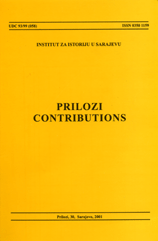Značajnija obilježja privredne i socijalne strukture u Bosni i Hercegovini 1931.-1941.
The More Significant Characteristics of the Economic and Social Structure in Bosnia-Herzegovina, 1931-1941.
Author(s): Ahmed HadžirovićSubject(s): History
Published by: Institut za istoriju
Summary/Abstract: In the period between the two world wars in B-H was 84,1% of active population in economy or 854.747 inhabitants, while in agriculture was employed 84,45% of the population. The social economic postition of the villages was almost according the demographic and economic structure. In industry, mines and crafts were 6,7% or 68.236 employed people. Of trade, loans and sale lived 3,1% or 31.960 people. In public sector and free professions, military, were 3,6% or 36.452 employed people. The rest of 2,5 or 25.357 employed covers the rest. The employment in the main professions in B-H, the economic structure was according the Yugoslav average. In B-H more people were employed in agriculture than in the rest of Yugoslavia. On the other side are the parts of the population employed in industry, trade, loan business, public sector and free professions. Such an economic structure had no possibility to employ the new man-power from the high increase of the population. The biggest part of the population stayed in villages and worked there. Considering the fact that 45 new factories were built up in the country, between 1929 and 1938, in B-H goes for only 7% of the Yugoslav factories with 9,8% investments, 10,8% of the installed energy and 10,4% of all jobs. B-H had an unenviable position in the Yugoslav trade of that time.
Journal: Prilozi
- Issue Year: 2001
- Issue No: 30
- Page Range: 143-162
- Page Count: 20
- Language: Bosnian

